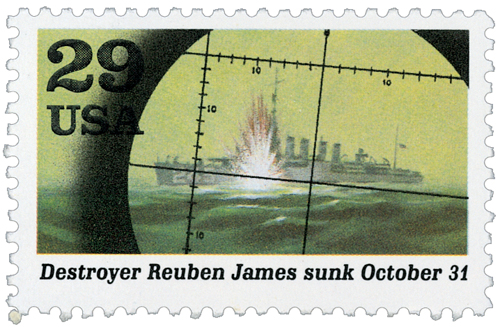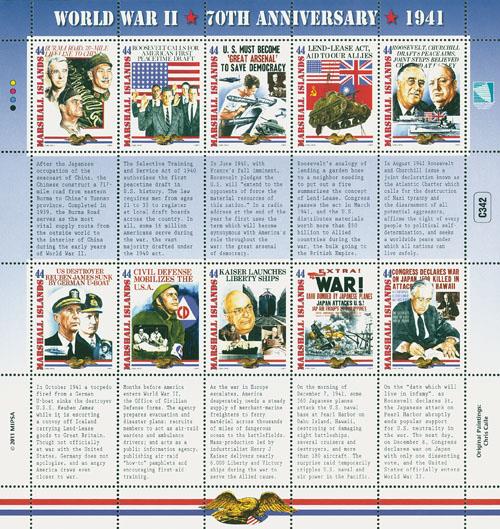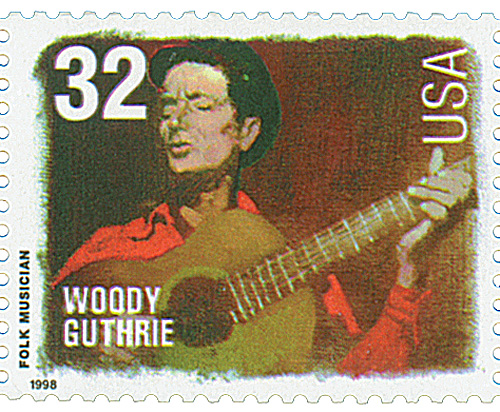
# 3213 - 1998 32c Folk Musicians: Woody Guthrie
1998 32¢ Woody Guthrie
Folk Musicians
City: New York, NY
Quantity: 250,000,000
Printed By: Banknote Corporation of America
Printing Method: Lithographed
Perforations: Die Cut 11.3
Color: Multicolored
Sinking Of The USS Reuben James

On October 31, 1941, a German submarine torpedoed the USS Reuben James – the first US Navy ship destroyed during World War II.
The USS Reuben James was named after a naval hero who was born sometime around 1776. James joined the US Navy and served on several ships.

During the Barbary Wars, James was on the Enterprise with Lieutenant Stephen Decatur in the harbor at Tripoli. They attempted to burn the captured American ship the Philadelphia. When the brave sailors boarded the ship, they realized it was guarded by the pirates who had captured it. During the fighting, James stepped between a pirate’s sword and Lieutenant Decatur and was wounded. He survived the wound and continued to serve in the Navy in the War of 1812 and beyond. He died in a Naval Hospital in 1838.

The ship named in honor of this brave sailor was commissioned in September 1920. The USS Reuben James sailed in the Adriatic and Mediterranean Seas, assisting refugees from Yugoslavia. In October 1921, the ship joined in ceremonies marking the return of the Unknown Soldier to the US. After returning to American shores, the Reuben James patrolled the Nicaraguan coast to prevent weapons from being delivered to revolutionaries. After more than a decade of service, the destroyer was taken out of commission in 1931.

The services of the Reuben James were needed again the next year to patrol the waters around Cuba. When war began in Europe in September 1939, this ship guarded the Atlantic and Caribbean waterways as part of the Neutrality Patrol. In March 1941, the destroyer was part of a convoy that brought war materials safely to Britain.

On October 23, 1941, the Reuben James sailed from Newfoundland with four other destroyers escorting a convoy. In the early hours of October 31, the convoy encountered a German “wolfpack” – a group of submarines in position to attack the convoy. The Reuben James positioned itself in front a merchant ship that one of the German U-boats was targeting.

The U-boat fired its torpedo, which struck the Reuben James, exploding a magazine and blowing off the entire bow. The bow immediately sank and the rest of the ship floated for about five minutes before sinking as well. The ship had seven officers, 136 enlisted men and one passenger. Of these, 100 were killed – only 44 enlisted men survived the attack. The Reuben James was the first US Navy ship to be destroyed in World War II.

After this event, the US Navy was ordered to attack German and Italian war vessels in the Atlantic Ocean. In December, the attack on American soil at Pearl Harbor would push the United States into full-scale war.
Click here to listen to Woody Guthrie’s “The Sinking of the Reuben James.”
1998 32¢ Woody Guthrie
Folk Musicians
City: New York, NY
Quantity: 250,000,000
Printed By: Banknote Corporation of America
Printing Method: Lithographed
Perforations: Die Cut 11.3
Color: Multicolored
Sinking Of The USS Reuben James

On October 31, 1941, a German submarine torpedoed the USS Reuben James – the first US Navy ship destroyed during World War II.
The USS Reuben James was named after a naval hero who was born sometime around 1776. James joined the US Navy and served on several ships.

During the Barbary Wars, James was on the Enterprise with Lieutenant Stephen Decatur in the harbor at Tripoli. They attempted to burn the captured American ship the Philadelphia. When the brave sailors boarded the ship, they realized it was guarded by the pirates who had captured it. During the fighting, James stepped between a pirate’s sword and Lieutenant Decatur and was wounded. He survived the wound and continued to serve in the Navy in the War of 1812 and beyond. He died in a Naval Hospital in 1838.

The ship named in honor of this brave sailor was commissioned in September 1920. The USS Reuben James sailed in the Adriatic and Mediterranean Seas, assisting refugees from Yugoslavia. In October 1921, the ship joined in ceremonies marking the return of the Unknown Soldier to the US. After returning to American shores, the Reuben James patrolled the Nicaraguan coast to prevent weapons from being delivered to revolutionaries. After more than a decade of service, the destroyer was taken out of commission in 1931.

The services of the Reuben James were needed again the next year to patrol the waters around Cuba. When war began in Europe in September 1939, this ship guarded the Atlantic and Caribbean waterways as part of the Neutrality Patrol. In March 1941, the destroyer was part of a convoy that brought war materials safely to Britain.

On October 23, 1941, the Reuben James sailed from Newfoundland with four other destroyers escorting a convoy. In the early hours of October 31, the convoy encountered a German “wolfpack” – a group of submarines in position to attack the convoy. The Reuben James positioned itself in front a merchant ship that one of the German U-boats was targeting.

The U-boat fired its torpedo, which struck the Reuben James, exploding a magazine and blowing off the entire bow. The bow immediately sank and the rest of the ship floated for about five minutes before sinking as well. The ship had seven officers, 136 enlisted men and one passenger. Of these, 100 were killed – only 44 enlisted men survived the attack. The Reuben James was the first US Navy ship to be destroyed in World War II.

After this event, the US Navy was ordered to attack German and Italian war vessels in the Atlantic Ocean. In December, the attack on American soil at Pearl Harbor would push the United States into full-scale war.
Click here to listen to Woody Guthrie’s “The Sinking of the Reuben James.”











